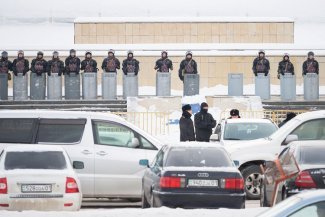The leaders of China, Russia and Mongolia talk during the summit in Samarkand, Uzbekistan, on 15 September 2022.
China has displaced Russia as the dominant power in Central Asia. It has done so thanks to its diplomatic and economic might. China’s transport infrastructure is changing the flow of trade with Central Asian economies wary of Russia’s invasion of Ukraine and international sanctions on Moscow. Russia’s decline shows the weakness of a relationship with Central Asia based on Moscow’s military superiority. It is against this backdrop that China is emerging as a pragmatic, Asian alternative to European coercion.
The past two decades have seen Moscow and Beijing reach something of an ‘entente cordiale’ over their role in Central Asia, which has enabled China to expand its trade network in a region that is largely heir to Russian and Soviet expansion in Asia, and Russia to focus its attention on the security sphere.
Following the defeat of the Taliban in Afghanistan in 2001, Russia returned with considerable strength to Central Asia’s defence and security arena, surpassing the incipient efforts of the US and NATO to extend their sphere of influence. But things began to change in the middle of last decade, following Russia’s annexation of Crimea, support for pro-Russian separatists in Ukraine’s Donbas region and Moscow’s increasingly aggressive diplomatic relations with its former Central Asian bedfellows.
Central Asia’s confidence in Moscow shattered by Russian interventionism
The invasion and war in Ukraine served to confirm the doubts already raised in Central Asia. Shortly before 24 February, Russia’s interference in the unrest in Kazakhstan, in January, had already heightened concerns among Central Asian governments that the role Moscow wanted to assume in the security arena throughout the former Soviet bloc was not limited to regular joint exercises or its pre-eminence in the Collective Security Treaty Organization (CSTO, comprising Armenia, Belarus, Kazakhstan, Kyrgyzstan, Russia and Tajikistan).
Protests by thousands of citizens over the hike in liquefied natural gas prices in some of Kazakhstan’s major cities in January led to the deployment of Russian-led CSTO troops, the removal of former Kazakh president Nursultan Nazarbayev as chair of the country’s security council and the strengthening of the current head of state, Kassym-Jomart Tokayev, a figure conveniently close to Moscow.
In Kazakhstan and the other Central Asian countries, these events and their outcome were perceived as clear intervention by a Russia wanting to bolster its waning presence.
The recent summits in Samarkand (Shanghai Cooperation Organisation, on 16 September) and Astana (Russia-Central Asia, on 13 October) underscored the weakening of Russia’s position in the region.
The regional meeting in the Uzbek city also underlined the growing appreciation for China among Central Asian leaders. Only Turkey stood out as a minor rival to China in Central Asia, thanks to the efforts made by Turkish diplomats and businessmen during the 1990s.
The consolidation of President Xi Jinping at the 20th National Congress of the Chinese Communist Party, held between 16 and 22 October, has reminded Central Asian countries of similar processes experienced in the days when they were part of the USSR. The need for a strong leader, as in the case of China, is not seen as a threat in Central Asia but as a sign of stability in a region where democratic institutionalisation leaves much to be desired.
While the Russian president, Vladimir Putin, was once seen as a good example of such stability for Central Asian leaders, the war in Ukraine has shattered that confidence.
The new Silk Road
The withdrawal of the United States from Afghanistan in August 2021, with the immediate return of the Taliban to Kabul, has been another major source of upheaval in Central Asia since the beginning of the decade. This agreed exit, which nevertheless brought Washington into a degree of disrepute, was immediately seized upon by China as an opportunity to send its trade envoys to the country. It has left one thing clear: unlike Russia or the United States, China’s interest is unlikely to be accompanied by tanks or attack helicopters.
During the 19th century, Central Asia was the scene of the so-called ‘Great Game’ between the Russian and British spheres of influence in that part of the world, with Afghanistan as the strategic hub, and a rivalry stretching to former Turkestan, which was eventually conquered by the Tsarist Empire. Russia’s influence in Afghanistan surged with its invasion of the country in 1979 and plummeted with its withdrawal in 1989.
China, also a field of action for Russian and British imperialism, had very little involvement in the 19th century Great Game or ‘Shadow Tournament’, as it was called in Russia. The communist revolution in China was centred on the country itself, and the only territory into which it expanded was Tibet. After the fall of the Soviet Union, Beijing would have to wait a few more years before deciding to look towards Central Asia, with less ideological and much more economic interest. The Beijing government quietly watched the war against the Taliban in 2001 and let the dust settle before sending out its trade missions.
And it was President Xi Jinping who traced the best roadmap to Central Asia. It was the vision set out by Xi, who had just come to power, that drove the Belt and Road Initiative in 2013.
The initiative focuses on the large-scale development of transport infrastructure, particularly railways and roads, but also ports (in East Asia, the Middle East and Turkey) and special economic zones. The land and sea branches of the new Silk Road were starting to take shape as global trade routes, as they were in the Middle Ages.
In less than a decade, China’s gambit had surpassed all expectations and Beijing had displaced Moscow. And not only Moscow but Washington too, which suddenly realised that China was becoming a very powerful rival to US hegemonism in Eurasia.
China is also suffering from the ravages of the war
The invasion of Ukraine has been the final blow to Russia’s credibility in Central Asia, but the war is not helping China’s overall strategy in the region either. While it is taking advantage of Moscow’s discrediting to occupy some of the business niches that were still in the hands of Russian companies, the economic crisis triggered by the conflict, with inflation and rising food and fuel prices, is very damaging to China. The war is disrupting Chinese business around the world, and especially in Asia.
And the erosion of its Russian neighbour’s power as a deterrent and a military force is also a problem for China, which is under pressure from the United States in the Pacific, not least when it comes to Washington’s support for Taiwan.
In Central Asia, however, the United States’ moves to isolate China and reduce its role to that of a global manufacturer of electronic components are failing. The regional summits in Uzbekistan and Kazakhstan have underlined the respect that Central Asian countries have for Beijing and their interest in having a partner close by and that, despite the threats it may pose in terms of its huge economic and security potential, offers an alternative, at least, to the aggressiveness of Russia and the US.
It is true that China’s policy in its north-western region of Xinjiang is a thorny issue in Central Asia, given the persecution of the Uyghurs, who are of Turkic origin, like the predominant ethnic groups in the neighbouring states.
Reports by Amnesty International and Human Rights Watch of massive human rights violations in Xinjiang are growing and creating widespread unease in Central Asian countries.
But Central Asian governments have not shown themselves to be very orthodox when it comes to complying with international human rights agreements either and, at the end of the day, it is money that allows these governments to stay in power. While, in the past, the Great Game in Central Asia was driven by geo-strategy and ideology, today, it is pragmatism that prevails, and there is no country in Asia more pragmatic than China, for better and for worse.
In any case, and much will depend on what happens in Ukraine in the coming months, the relationship between Moscow and Beijing does not necessarily have to end in rivalry, given the potential for cooperation between the two countries, especially in the transport of hydrocarbons. In 2024, for example, construction will begin on the Power of Siberia II pipeline, which will be able to ship 50 billion cubic metres of gas a year from Russia to China.
But there is one thing that seems irreversible. Even if a ceasefire and armistice is reached in Ukraine, it does not look like the pumping of gas and oil from Russia to Europe will resume, at least not in the medium term. In these circumstances, China is clearly set to become the main and priority market for Russian fuel: geostrategic pragmatism underpinned by energy pragmatism.













